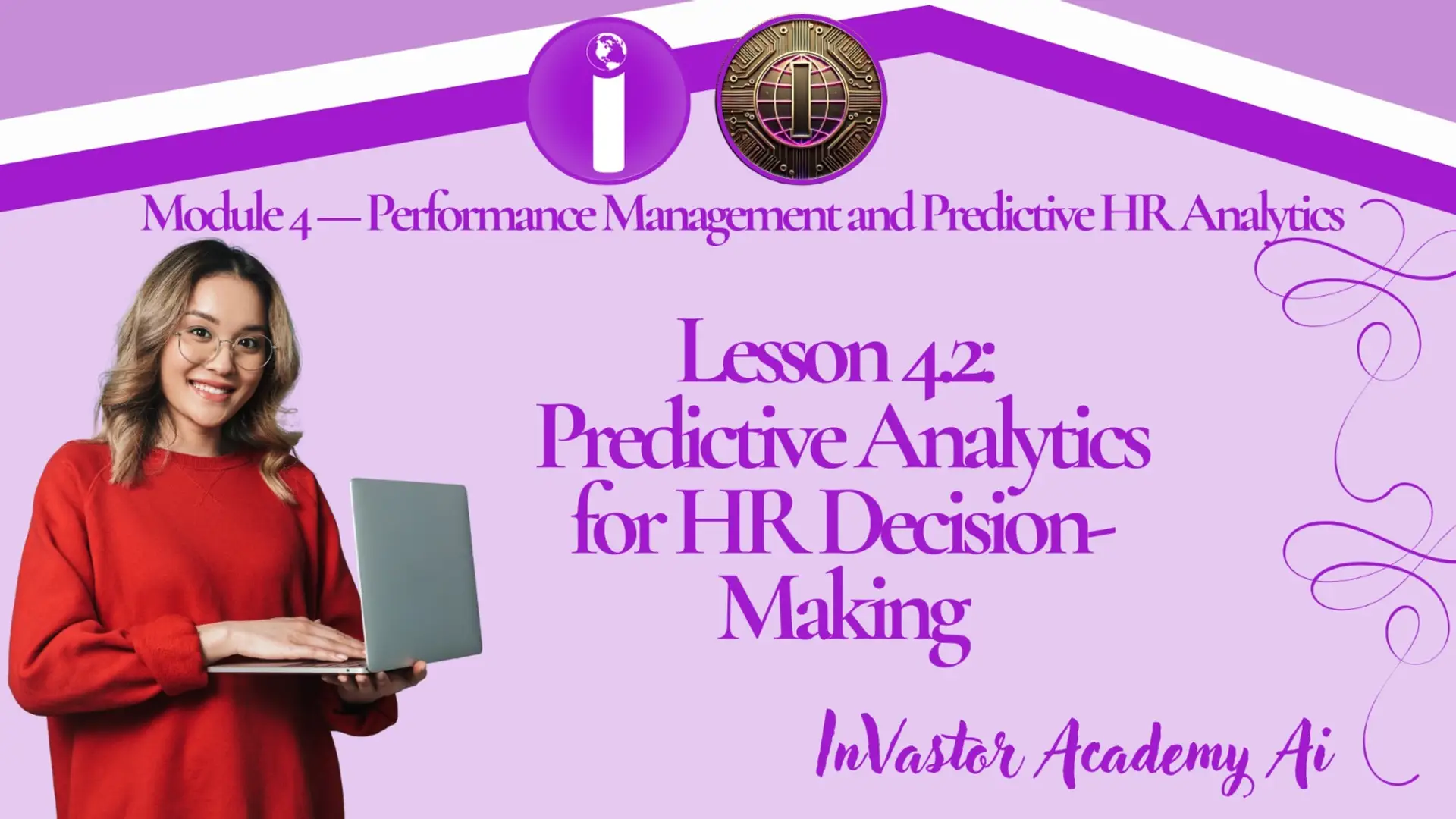

Lesson 4.2 — Predictive Analytics for Employee Performance and Retention
Module 4 — Performance Management and Predictive HR Analytics
Lesson 4.2 — Predictive Analytics for Employee Performance and Retention
Learning Objectives
By the end of this lesson, learners will be able to:
- Define predictive analytics and explain its application in HR.
- Identify key data inputs used to forecast employee performance and retention.
- Describe how AI models help predict turnover risks and engagement trends.
- Analyze real-world examples of predictive HR analytics in organizations.
- Evaluate the ethical and strategic implications of using predictive insights in HR decisions.
1️⃣ Introduction: Predicting the Future of Workforce Performance
In a competitive and data-driven workplace, organizations can’t afford to wait for performance or retention problems to appear — they must anticipate them.
Predictive analytics enables HR teams to forecast employee outcomes by analyzing historical data and identifying patterns that signal future behaviors.
AI models use these insights to help HR leaders make proactive decisions — from retention strategies to performance improvement plans.
Example:
IBM’s predictive HR model reportedly achieved 95% accuracy in identifying employees likely to leave, helping the company save millions in turnover costs.
2️⃣ What Is Predictive Analytics in HR?
Predictive analytics is the process of using historical and current data to forecast future events or behaviors.
In HR, it helps answer questions like:
- Who is likely to become a top performer?
- Which employees might be at risk of leaving?
- What factors contribute most to engagement or burnout?
Key Components of Predictive HR Models:
- Data Collection: Gathering employee, performance, and engagement data.
- Data Analysis: Identifying correlations and risk indicators.
- Machine Learning Models: Using algorithms to predict outcomes.
- Actionable Insights: Turning predictions into strategic HR actions.
3️⃣ Key Data Sources for Predictive Analytics
Data Type Examples Purpose
Demographic Data Age, tenure, job level Identify patterns by workforce segments
Performance Data KPIs, goals, manager ratings Predict productivity or growth potential
Engagement Data Surveys, feedback, recognition Measure satisfaction and motivation
Behavioral Data Attendance, communication, collaboration Detect early signs of disengagement
Learning Data Training progress, skill upgrades Predict future role readiness
Example:
A financial firm used predictive analytics to identify early warning signs of burnout (e.g., longer work hours, reduced feedback), allowing HR to intervene with wellness programs.
4️⃣ Predictive Models in Action
✅ Performance Prediction Models
AI evaluates productivity trends, skill acquisition rates, and team collaboration data to identify potential top performers.
✅ Attrition Prediction Models
By analyzing turnover data, satisfaction scores, and workload patterns, HR can forecast which employees are at risk of leaving.
✅ Engagement Prediction Models
Predictive analytics helps determine which factors most influence employee morale — such as leadership support, workload, or recognition frequency.
✅ Career Pathing Models
AI identifies likely career progression paths and recommends learning opportunities for each employee.
Example:
Amazon and Microsoft use predictive analytics to plan internal mobility programs — ensuring employees move into roles that match their skills and career goals.
5️⃣ Benefits of Predictive Analytics in HR
🌟 Proactive Decision-Making: HR can act before issues arise.
🌟 Personalized Employee Experiences: Tailored retention and development plans.
🌟 Reduced Turnover Costs: Early identification of flight-risk employees.
🌟 Enhanced Productivity: Data-driven insights for coaching and goal setting.
🌟 Fairer Evaluations: Objective, evidence-based assessment of employee potential.
6️⃣ Ethical and Strategic Considerations
⚠️ Data Privacy: Predictive models must protect sensitive employee information.
⚠️ Algorithmic Bias: Models trained on biased data may produce unfair predictions.
⚠️ Transparency: Employees should understand how predictions are made and used.
⚠️ Over-Reliance on Automation: Predictions should support, not replace, human judgment.
⚠️ Consent and Communication: Employees should be informed about how their data contributes to analytics.
Example:
If an AI tool predicts low performance due to bias in historical data (e.g., gender or age), it may reinforce discrimination rather than solve it — making ethical oversight essential.
7️⃣ Best Practices for Implementing Predictive Analytics in HR
✅ Start small — test one area (e.g., turnover prediction) before scaling.
✅ Ensure data quality and eliminate outdated or biased datasets.
✅ Combine AI insights with managerial feedback and HR expertise.
✅ Use analytics for supportive, not punitive, decision-making.
✅ Continuously review and recalibrate predictive models for fairness and accuracy.
8️⃣ Practical Activity
Task:
Design a predictive HR analytics plan for your organization.
Include:
- The specific HR question you want to predict (e.g., “Who is at risk of leaving?”).
- The data sources and indicators you’ll analyze.
- The predictive tools or models to use.
- Ethical and communication strategies to ensure transparency.
9️⃣ Supplementary Resources
- 🎥 “Predictive Analytics in HR: The Future of Workforce Planning” — Gartner HR Insights
- 🎥 “How IBM Uses AI to Predict Employee Retention” — Harvard Business Review
- 🎥 “Predictive People Analytics: Turning Data into Strategy” — McKinsey & Company
- 🎥 “The Ethics of Predictive HR Analytics” — World Economic Forum
Lesson Quiz 4.2
Please complete this quiz to check your understanding of the lesson. You must score at least 70% to pass this lesson quiz. This quiz counts toward your final certification progress.
Answer the quiz using the Google Form below.
Click here for Quiz 4.2
Conclusion
Predictive analytics is revolutionizing HR by transforming data into strategic foresight.
By combining AI technology with human judgment, HR professionals can create more personalized, fair, and effective talent strategies.
💡 “Predictive HR isn’t about guessing the future — it’s about shaping it.”
📘 Next Lesson: Lesson 4.3 — Using AI to Identify and Develop High-Potential Employees
📘 Previous Lesson: Lesson 4.1 — Data-Driven Performance Tracking
📘 Course Outline: Module 4 — Performance Management and Predictive HR Analytics
Related Posts
© 2025 Invastor. All Rights Reserved

User Comments